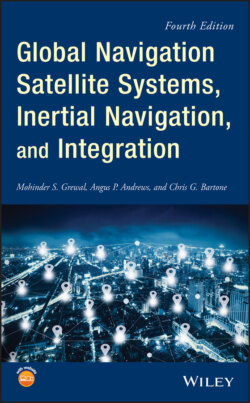Читать книгу Global Navigation Satellite Systems, Inertial Navigation, and Integration - Mohinder S. Grewal - Страница 44
1.3.2.2 Sensor Attitude Control
ОглавлениеMethods by which the information from gyroscopes is used for resolving acceleration inputs into suitable coordinates for integration can be divided into two general approaches:
1 Inertial stabilization of the accelerometer input axes, using the gyroscopes. The first precise and reliable integrating accelerometer was invented in Germany by Fritz Mueller (1907–2001) in the 1930s [18]. Its proof mass is a MWG mounted such that its center of mass is offset axially from its center of support within its enclosure, causing the gyroscope to precess about the input acceleration axis at an angular rate proportional to specific force applied orthogonal to its spin axis, and accumulating a net precession angle proportional to velocity change in that direction. However, because it contains a MWG, it is also sensitive to rotation. That error source could be eliminated by maintaining Mueller's gyroscope in a fixed inertial direction, and the German visionary Johannes Boykow (1879–1935) played a significant role in developing an approach by which the outputs of rotation sensors could be fed back in servo control loops to gimbals nulling the inertial rotations of the ISA [18]. The result is now called an inertially stabilized platform or inertial platform, and the resulting INS is called “gimbaled.”
2 Strapdown systems use software to replace hardware (gimbals), processing the gyro outputs to maintain the coordinate transformation between accelerometer‐fixed coordinates and (essentially) inertial platform coordinates. The accelerometer outputs can then be transformed to what would have been inertial platform coordinates and processed just as they had been with a gimbaled system – without requiring an inertial platform. Getting rid of gimbals reduces INS weight and cost, but it also increases computer requirements. As a consequence, strapdown system development had to await the essential computer development, which did not happen until the mid‐twentieth century. However, as silicon‐based technologies advanced to produce chip‐based sensors and computers, only high‐end inertial systems would require gimbals.
